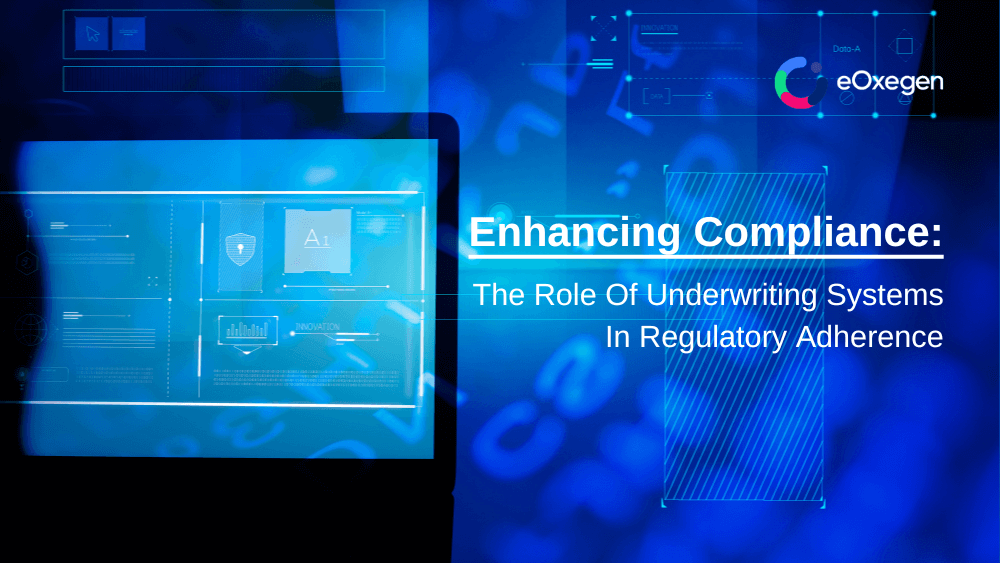Enhancing Compliance: The Role of Underwriting Systems in Regulatory Adherence
7 Feb, 2024

Underwriting is the process of assessing and calculating the financial risk associated with a business or an individual. It typically takes place when an investment is being made, an insurance policy is being issued, or a loan is being extended. Underwriting specialists are employed by a number of financial institutions to complete this assessment process. The purpose of this risk assessment is to safeguard the interests of banks, applicants, investors, and the financial market at large in the context of financial agreements and transactions.
Amidst this dynamic backdrop, the role of underwriting systems has become pivotal. These systems, driven by advanced technologies, not only streamline operational processes but also play a crucial role in ensuring compliance with the ever-evolving regulatory landscape.
The Evolving Regulatory Landscape
The insurance industry operates within a dynamic regulatory landscape, shaped by ever-changing laws and standards. In response to this fluid environment, insurance underwriting software solutions have emerged as a cornerstone in achieving and maintaining compliance. These systems leverage sophisticated technology to streamline underwriting processes and align them with the latest regulatory requirements.
Achieving Compliance with Underwriting Software
These underwriting systems streamline operational processes and ensure adherence to the latest regulatory requirements. By leveraging sophisticated technology, these systems automate underwriting tasks, standardize workflows, and incorporate compliance checks directly into the underwriting process. This integration of compliance checks helps insurers identify and address regulatory concerns proactively, reducing the risk of non-compliance and regulatory penalties.
Moreover, underwriting software solutions prioritize data security and privacy, implementing robust encryption, access controls, and data protection measures. These measures are essential for complying with data protection regulations such as GDPR and HIPAA, safeguarding sensitive applicant information, and reducing the risk of data breaches.
Additionally, underwriting systems maintain comprehensive audit trails and documentation of underwriting decisions. These audit trails track the entire underwriting process, from initial application submission to final decision, enabling insurers to demonstrate compliance during regulatory audits and inspections. This transparency and accountability are crucial for maintaining trust and credibility in the financial industry.
Modern underwriting software stands out as a comprehensive solution for achieving compliance seamlessly. Its capabilities go beyond mere automation, offering distinct advantages over traditional manual processes. Let's explore how insurance underwriting software contributes to achieving compliance:
Consistency and Error Prevention
Underwriting software ensures consistency in both processes and decision-making. By automating routine tasks, it significantly reduces the risk of manual errors, a crucial factor in compliance management. This not only enhances operational efficiency but also fortifies the underwriting process against inadvertent regulatory violations.
Tracking, Analysis, and Audit Trail
The software establishes processes that are easily trackable, analyzable, and auditable. This transparency is invaluable for regulatory adherence, providing underwriters with a clear trail of activities. This audit trail becomes a critical asset during regulatory audits, showcasing the adherence to compliance procedures.
Automated Alerts for Non-Compliance
Underwriting software acts as a proactive compliance partner by automatically alerting underwriters to conditions that might lead to non-compliance. This real-time alert system empowers underwriters to address potential issues promptly, mitigating risks and ensuring adherence to regulatory standards.
Configuration and Decision Rules
Underwriting software allows insurers to configure and customize underwriting rules based on their specific business requirements and regulatory obligations. Insurers can define decision rules for various underwriting criteria, such as risk assessment, eligibility criteria, and pricing guidelines. By configuring decision rules within the software, insurers ensure consistency and accuracy in underwriting decisions while complying with regulatory standards.
User Control and System Configuration
Underwriting software for insurance provides a user-friendly interface that allows underwriters to control system configurations. This means assigning roles and responsibilities to qualified individuals without requiring technical skills. The system maintains a comprehensive record of all configuration changes, offering transparency and accountability in compliance management.
Data-Driven Decisions and Regulatory Compliance
In the era of abundant data, underwriting software integrates seamlessly with various data sources and services to enhance the decision-making process. Incorporating identity verification, alternative credit data, and document services, underwriters can avoid risks associated with identity fraud, structure effective loan terms, and maintain an auditable record of communications - all vital components of regulatory compliance.
Maintaining Compliance with Technological Agility
Regulations are not static; they evolve over time. Underwriting software ensures that maintaining compliance is as agile as achieving it. Authorized individuals can effortlessly reconfigure menus, workflows, decision rules, and data integrations as regulations change. Testing these configurations before implementation safeguards against unforeseen impacts on qualification attributes, maintaining compliance effectively.
Conclusion
The role of underwriting software in enhancing compliance cannot be overstated. Its integration of advanced technologies, configurable decision rules, and data-driven insights provides underwriters with the tools needed to navigate the complex regulatory landscape successfully. As the regulatory environment continues to evolve, underwriting software stands as a steadfast ally, ensuring insurance companies adhere to the highest standards while streamlining their underwriting processes.
Recent Articles
- How do Big Insurers Engage with the New-Age InsurTech Companies?
- Insurance Management System Integration: Maximizing Efficiency and Performance
- Will Blockchain Technology Reshape the Insurance Market?
- The Future of Health Insurance: Predictive Analytics and AI
- Buy or Build Insurance Software? A Game-Changing Question in Insurance Industry